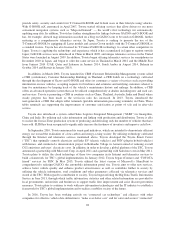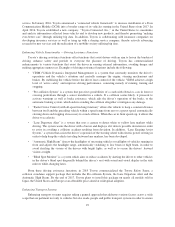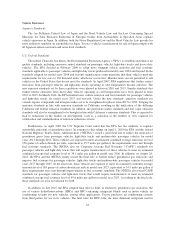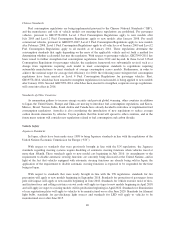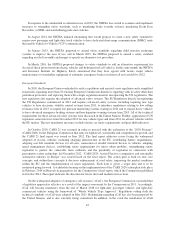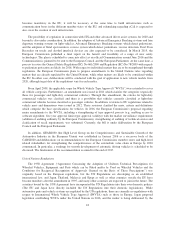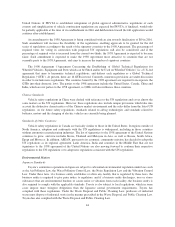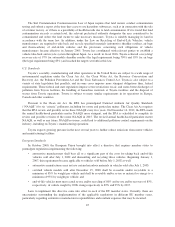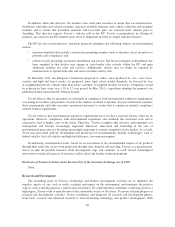Toyota 2015 Annual Report Download - page 43
Download and view the complete annual report
Please find page 43 of the 2015 Toyota annual report below. You can navigate through the pages in the report by either clicking on the pages listed below, or by using the keyword search tool below to find specific information within the annual report.Vehicle Fuel Economy
Japanese Standards
The Law Concerning the Rational Use, etc. of Energy requires automobile manufacturers to improve their
vehicles to meet specified fuel economy standards. Fuel economy standards are established according to the
types of vehicles specified below, and are required to be met by either fiscal 2011 (April 2010-March 2011),
fiscal 2016 (April 2015-March 2016), fiscal 2021 (April 2020-March 2021) or fiscal 2023
(April 2022-March 2023).
Among qualifying passenger vehicles are:
• Vehicles which are designated in Article 75, Paragraph 1 of the Road Vehicles Law as type-designated
vehicles (“type-designated vehicles”) with 10 seats or less using gasoline, gas oil or LPG;
• Type-designated vehicles with 11 seats or more that are 3.5 tons or less in vehicle weight using gasoline
or gas oil; and
• Type-designated vehicles with 11 seats or more that are over 3.5 tons in vehicle weight using gas oil, or
designated carbon monoxide emission control vehicles (“designated carbon monoxide emission control
vehicles”) which are designated in Article 75-3 Paragraph 1 of the Road Vehicles Law.
Among qualifying cargo vehicles are:
• Type-designated vehicles that are 3.5 tons or less in vehicle weight using gasoline, gas oil or LPG; and
• Type-designated vehicles that are over 3.5 tons in vehicle weight using gas oil or LPG, or designated
carbon monoxide emission control vehicles.
Toyota is in compliance with the fuel economy standards that currently apply and is promoting the
improvement of its vehicles in order to achieve compliance with the standards that will apply beginning in fiscal
2021.
Japan is a signatory to the Framework Convention on Climate Change and has agreed to take measures to
reduce its greenhouse gas emissions. Improved vehicle fuel economy is contributing to the reduction in carbon
dioxide emissions.
U.S. Standards
The Federal Motor Vehicle Information and Cost Savings Act requires automobile manufacturers to comply
with CAFE standards. Under this law, limits are imposed on the amount of regulated pollutants that may be
emitted by new motor vehicles in the United States. A manufacturer is subject to substantial civil penalties if, in
any model year, its vehicles do not meet the CAFE standards. Manufacturers that exceed the CAFE standards
earn credits determined by the difference between the average fuel economy performance of their vehicles and
the CAFE standards. Credits earned for the five model years preceding the current model year, and credits
projected to be earned for the next three model years, can be used to meet CAFE standards in a current model
year.
In April 2006, the NHTSA established CAFE standards applicable to light-duty trucks for model year 2008
and beyond. These CAFE standards aimed at shifting the framework from one that used to be advantageous only
to compact car manufacturers to one that is fair to full line manufacturers. The requirements were changed so that
the CAFE standards are now determined by a sales rate based on vehicle size (measured by the area of the wheel
and wheel base) for each manufacturer.
On April 1, 2010, the EPA and the NHTSA issued a joint final rule to reduce the emission of greenhouse
gases from passenger vehicles, light-duty trucks and medium-duty passenger vehicles for model years 2012
38


